Fix: Something went wrong. Try restarting GeForce Experience
The error “Something went wrong. Try restarting GeForce Experience” usually occurs when your computer is unable to launch the GeForce Experience application properly. This error came into the spotlight recently when GeForce Experience 3.0 was launched by the company. Although it contained various new features and increased performance, it was not without its bugs and errors.

This error usually occurs when the user configuration of the NVIDIA application isn’t configured properly or is corrupted. Another troubleshooting result showed that failure to start some NVIDIA services was also the culprit to this problem. The errors range due to a variety of reasons as each computer has its own computer configuration. We have listed down all the available workarounds for this issue. Start from the top and work your way down.
Note: Before starting all the solutions, end-all Nvidia related processes from the task manager and try launching the application again. If it doesn’t, you can start troubleshooting from the solutions listed below.
Solution 1: Changing Compatibility of GeForce Experience
If you recently installed GeForce Experience on your computer, it is possible that the program is not compatible with your computer. Compatibility means that it is not suited to run on your computer hence the error message. We can try changing the compatibility settings of the GeForce application and see if this makes any difference. If this doesn’t work you, make sure to revert the settings back before you proceed with the other solutions.
- Right-click on the GeForce Experience application and select “Properties”.

- Navigate to the compatibility tab. Check both options “Run this program in compatibility mode for:” and “Run this program as an administrator”. You can choose different operating systems using the drop-down menu. Try using Vista or Win 7. Check using all versions before you move on to the next solution.
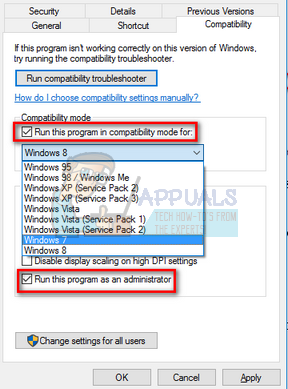
Solution 2: Reinstalling the Visual C++ Redistributable Packages
It is possible that there are some important system files missing from your computer. Without these files, GeForce Experience might be having trouble running. In order to replace the missing files, we can download the whole redistributable package and install it. Do note that you should always avoid downloading .dll files from the internet from non-official websites. They may be infected with malware and virus and can infect your computer easily.
Note: You should make sure that also all the latest Windows Updates are installed on your computer. Sometimes it is the case that a particular bug or error is fixed in different patches. Make sure that everything is updated beforehand before moving on to more technical solutions listed below.
- Head over to the official Microsoft downloading
- Click the Download button after selecting the language.
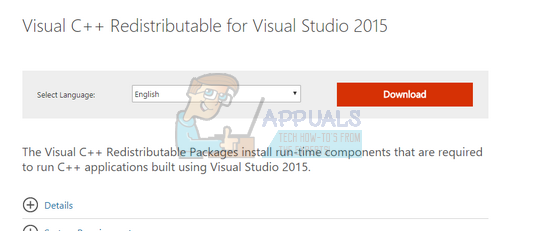
- Select “vc_redistx64.exe” and press Next. Soon after the download will commence. Save the file in an accessible location and run the exe file.
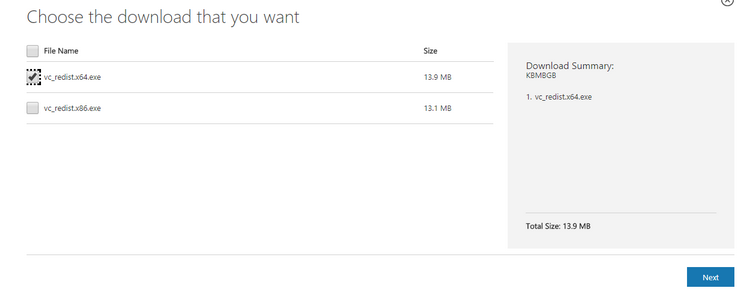
- After the installation is complete, restart your computer and check if the problem is solved.
Note: If you are using 64 bit Windows, you can install both (vredist_x64.exe and vredist_x86.exe). However, if you have 32 bit, you should only install “vredist_x86.exe”. You can check which version of Windows you have by press Windows + S, type “system information” and open the application which comes forth.
Solution 3: Changing ‘NVIDIA Display Container LS’ Settings
Nvidia display container LS is a service responsible for containing all Nvidia root features. Root features include all the essential features required to run all the applications and services properly without any problems. Many users reported that it was due to this service not stating that they couldn’t launch the GeForce Experience. By default, the startup type for this application is disabled. We will change the service settings and check if this solves the problem for us.
- Press Windows + R, type “services” in the dialogue box and press Enter.
- Navigate through all the services until you find “NVIDIA Display Container LS”. Right-click it and select ‘Properties’.

- Click on “Startup type” and select ‘Automatic’. Press “Apply” to save changes and exit.
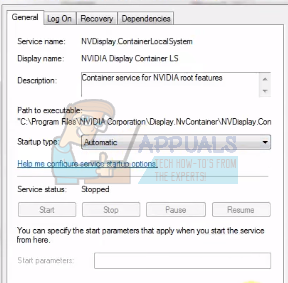
- Right-click on the service and click on ‘Start’ to force start the service.
- Press Windows + R, type “msconfig” and press Enter.
- Navigate to ‘Services’ tab and check the line “Hide all Microsoft services”. Now all the operating system services will be stopped leaving behind all third-party services.
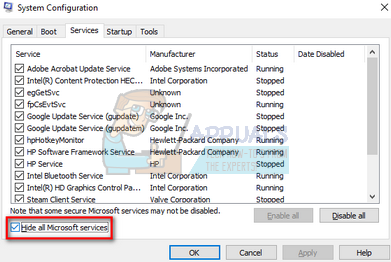
- Search of all Nvidia related services present and ensure that they are all checked. Press Apply to save changes and exit.
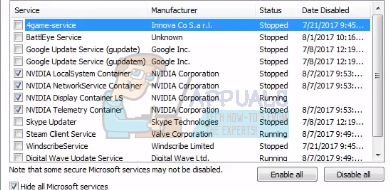
- Restart your computer properly and try launching GeForce Experience again. Hopefully, the problem will be solved.
Solution 4: Changing User Folder Name
Another workaround that worked for a lot of people was changing the name of the user folder present on your computer. We need to ensure that the user folder has a specific name so Nvidia services can easily access them without any hindrance. You should navigate to the file path ‘C:\Users\[User_Folder]’ and check if the name is correct. If the name is not as expected, rename it correctly i.e. name it “GF Experience”. Make sure that the name doesn’t contain any numeric characters. After renaming it, restart all Nvidia based services and check if the application works as expected. If it doesn’t, reboot your computer and check again.
Solution 5: Reinstalling the GeForce Application
Another quick fix that worked for many users was uninstalling the GeForce application before reinstalling a fresh version downloaded from the official website. The GeForce application might not be up-to-date or the application might have configuration issues with your system.
Note: If the latest version of GeForce doesn’t work on your computer, try downloading a previous version. Many users reported that the latest version has compatibility issues and doesn’t work on some computers in any case. Try downloading a previous one from a trustworthy website and check if this solves the problem.
- Press Windows + R, type “appwiz.cpl” in the dialogue box and press Enter.
- Once in the Programs and Features window, navigate through all the applications until you find GeForce Experience. Right-click it and select “uninstall”.
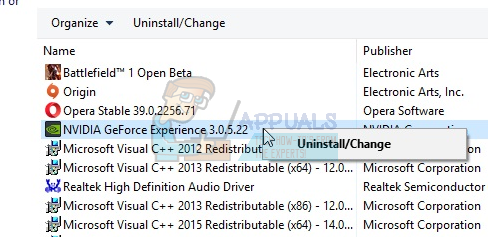
- After the uninstallation, download the latest version from Nvidia’s official website and install it accordingly.
- Restart your computer and check if the problem got solved. In some cases, you might need administrative privileges to install new applications on your computer.
Solution 5: Updating Graphics Driver
If all the above solutions don’t work, we can try updating the graphics driver. It may be possible that your graphics driver is not properly configured or is outdated. We need to completely delete all driver files before we install the new driver, therefore, we need to use the utility Display Driver Uninstaller. You can download the utility over the internet easily.
- After installing Display Driver Uninstaller (DDU), launch your computer in safe mode.
- After booting your computer into safe mode, launch the application which was just installed. Choose the option Safe Mode.
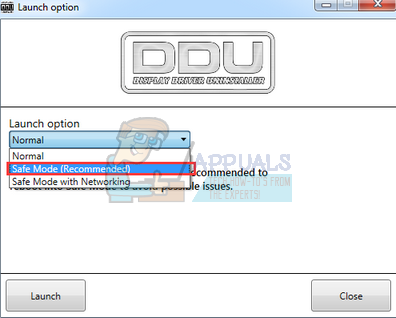
- After launching the application, select the first option “Clean and restart”. The application will then automatically uninstall the installed drivers and restart your computer accordingly.
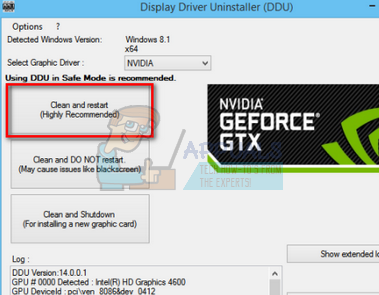
- Boot your computer into normal mode and launch the application. Open the “Drivers” tab and click the button “Driver Download”. Enter your specification on the right side of the screen and click “Start search” for the application to search for the optimal drivers for your computer.
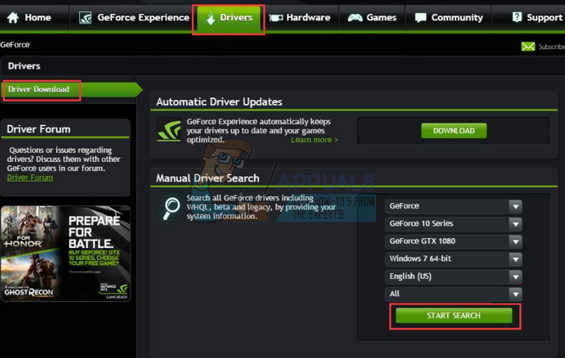
- After the driver is updated, restart your computer and check if the problem got solved.
Note: Often there are some applications that might be interfering with the application. Make sure that there are no such applications running on your computer. Also, try logging into an administrator account and check if the games get optimized successfully there.